
Purchase Tickets
It’s Not Just Dates: Building a Different Family History, Part 3
June 15, 2021

In the third and final installment of my blog series about my great-grandmother, we will explore her ethnic identity and how it has been carried into my generation. If you need to catch up on my previous blogs on this topic, you can visit Part 1 and Part 2.

Steve Sabol death notice (Hammond Times, June 19, 1939, page 51)
Whiting and other Northwest Indiana cities and towns had churches and numerous social and fraternal organizations that catered to the Slovak community. When my great-great-grandfather, Stephen Sabol, died in 1939, his death as reported in the Hammond Times newspaper, revealed a number of Slovak-centric groups to which he belonged: the Slovak Home, First Catholic Slovak Union of America, National Slovak Society, and the American-Slovak Citizens Club of Whiting. Looking for resources related to these organizations could yield more information about Stephen, his wife, and their children as their lives were likely impacted greatly by these organizations.

Reading Hovanec’s transcript on microfilm in the IHS Library (Indiana Historical Society)
Since I was young, I have belonged to the First Catholic Slovak Ladies Association. Although I am not active in the organization, historically some members of our family have been. Stephen Sabol’s daughter, my Great-Great Aunt Anna Hruskovich and her daughter, Florence Hovanec, were both heavily involved at the local and national levels. In my quest for items in the IHS collections about the Slovak community in Northwest Indiana, I stumbled upon a collection titled, Whiting, Indiana: Generational Memory in Modern America, Oral History Project. Formally housed at IU, IHS has copies of the transcripts on microfilm. I was able to read the transcript from a 1992 interview with my first cousin twice removed, Florence Hovanec. There was a lot of interesting information about her life in Robertsdale, and her participation in the local Catholic church, FCSLA, and the community. She also minimally discussed my great-great-grandparents, giving me a richer view of the family at large. While her first cousin, my grandmother, lived in Gary during her childhood, the family connection to Whiting was important.
Some things are more important than a geographic connection though. Food is an amazing way to explore one’s family history. As mentioned in the first blog in this series, one of my few memories of my Great Grandma J, Veronica Sabol Jadrnak, was having a sweet treat at her house. I vaguely recall being in her dining room where I was given a rosette cookie dusted with powdered sugar and a dollop of jelly in the center. As rosettes were originally a Scandinavian treat, questions bubble in my mind about the origin of the recipe in my family. Did it come from a cookbook?

My mother’s well-loved copy of the Slovak-American Cookbook (Author’s Family Collection)
One tie to the FCSLA that my family holds dear, as evidenced by my mother’s tattered copy shown above, is the group’s Slovak-American Cookbook, first published in 1952. My family has used this cookbook for the better part of a century. Clearly, we are not the only ones that treasure these recipes, the FCSLA notes that the book is now in its 26th printing and has sold over a quarter of a million copies.
While this is the Slovak-American Cookbook, and you can certainly find recipes with Slovak origins (holubky—cabbage rolls, cihak—Easter cheese, and more), we have our own tried and true family recipes for most of the Slovak classics! In this book, my familiy’s favorites are the ‘American’ recipes that these Slovak families adopted and adapted. When looking at the names of those who submitted recipes, we find Hruskovich, Hovanec, and other members of the Whiting branch of my Slovak family. Some of their recipes are the ones that we cherish and use to this day.
My mother recently purchased a copy of this cookbook for me. It’s nice to know I won’t have to call her when I want to make banana bread, barbecue beef (aka sloppy joes), and other recipes from this book.
The family grows and traditions continue.









